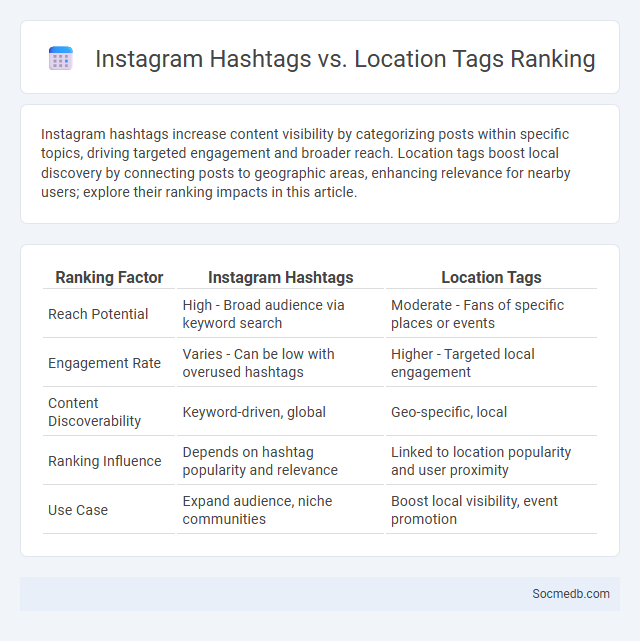
Photo illustration: Instagram Hashtags vs Location tags ranking
Instagram hashtags increase content visibility by categorizing posts within specific topics, driving targeted engagement and broader reach. Location tags boost local discovery by connecting posts to geographic areas, enhancing relevance for nearby users; explore their ranking impacts in this article.
Table of Comparison
| Ranking Factor | Instagram Hashtags | Location Tags |
|---|---|---|
| Reach Potential | High - Broad audience via keyword search | Moderate - Fans of specific places or events |
| Engagement Rate | Varies - Can be low with overused hashtags | Higher - Targeted local engagement |
| Content Discoverability | Keyword-driven, global | Geo-specific, local |
| Ranking Influence | Depends on hashtag popularity and relevance | Linked to location popularity and user proximity |
| Use Case | Expand audience, niche communities | Boost local visibility, event promotion |
Introduction to Instagram Ranking Factors
Instagram ranking factors determine the visibility and engagement of content on the platform, prioritizing posts based on relevance, user interaction, and timeliness. Key elements influencing ranking include user engagement metrics such as likes, comments, shares, and saves, as well as the relationship between the content creator and viewer. Algorithmic considerations also factor in content type preferences and frequency of interaction, optimizing personalized content delivery to enhance user experience.
Understanding Hashtags on Instagram
Hashtags on Instagram function as essential tools for categorizing content and increasing visibility across the platform's vast user base. By strategically using relevant and trending hashtags, users can connect with niche communities and boost engagement on their posts. Analyzing hashtag performance through Instagram Insights enables optimization of reach and audience targeting, enhancing overall social media strategy effectiveness.
What Are Instagram Location Tags?
Instagram location tags are geotags that users add to their posts or stories to specify a particular place, such as a city, business, or landmark. These tags enhance the visibility of your content by making it discoverable to others searching for posts from that location, increasing engagement and reach. Using Instagram location tags strategically can help you connect with local audiences and grow your presence in targeted areas.
How Does the Instagram Algorithm Work?
The Instagram algorithm prioritizes content based on user engagement, such as likes, comments, shares, and saves, to tailor the feed to individual preferences. It evaluates relationships by analyzing interactions between users, promoting posts from accounts with frequent communication. Timeliness also plays a crucial role, with newer posts given priority to ensure the feed remains fresh and relevant.
Hashtag Ranking: Benefits and Drawbacks
Hashtag ranking enhances visibility by categorizing content, making it easier for Your target audience to discover posts relevant to trending topics. While higher hashtag rankings can drive engagement and increase brand awareness, overusing popular hashtags may lead to content being lost in saturated feeds. Balancing niche and broad hashtags optimizes reach without compromising the uniqueness of Your social media presence.
Power of Location Tags for Increased Visibility
Location tags on social media posts significantly enhance visibility by connecting content to specific geographic areas, attracting localized audiences and businesses. Brands and influencers leverage location tags to boost engagement rates, as users often explore posts tagged in their area, leading to higher discoverability. Utilizing strategic location tagging effectively increases organic reach, drives foot traffic for local businesses, and fosters community interaction.
Algorithmic Ranking: How Instagram Prioritizes Content
Instagram's algorithmic ranking prioritizes content by analyzing user interactions such as likes, comments, shares, and time spent on posts to deliver personalized feeds. The platform uses machine learning to evaluate factors like recency, relationship strength, and content type relevance, ensuring users see posts most likely to engage them. Continuous data processing allows Instagram to adapt content prioritization dynamically, enhancing user experience and increasing session duration.
Comparing Engagement: Hashtags vs Location vs Algorithm
Analyzing social media engagement reveals that hashtags significantly enhance content discoverability by categorizing posts within niche interests, leading to increased user interactions. Location tags attract local audiences and drive engagement through community relevance, often boosting visibility in geographically targeted feeds. Algorithm-driven content curation prioritizes personalized user experiences by analyzing behavior patterns, resulting in higher engagement through tailored content delivery over generic hashtag or location use.
Best Practices for Maximizing Reach
Optimizing social media reach involves posting consistently during peak engagement hours identified through analytics tools. Utilizing targeted hashtags and engaging multimedia content increases visibility and interaction rates across platforms like Instagram, Facebook, and Twitter. Engaging with followers through comments and direct messages fosters community growth and enhances organic reach algorithms.
Conclusion: Choosing the Right Strategy for Your Content
Selecting the right social media strategy hinges on understanding your target audience's preferences, engagement patterns, and platform-specific algorithms. Tailoring your content to align with these factors maximizes reach and boosts interaction metrics. Your focus on data-driven decisions ensures sustained growth and meaningful connections across social channels.
 socmedb.com
socmedb.com